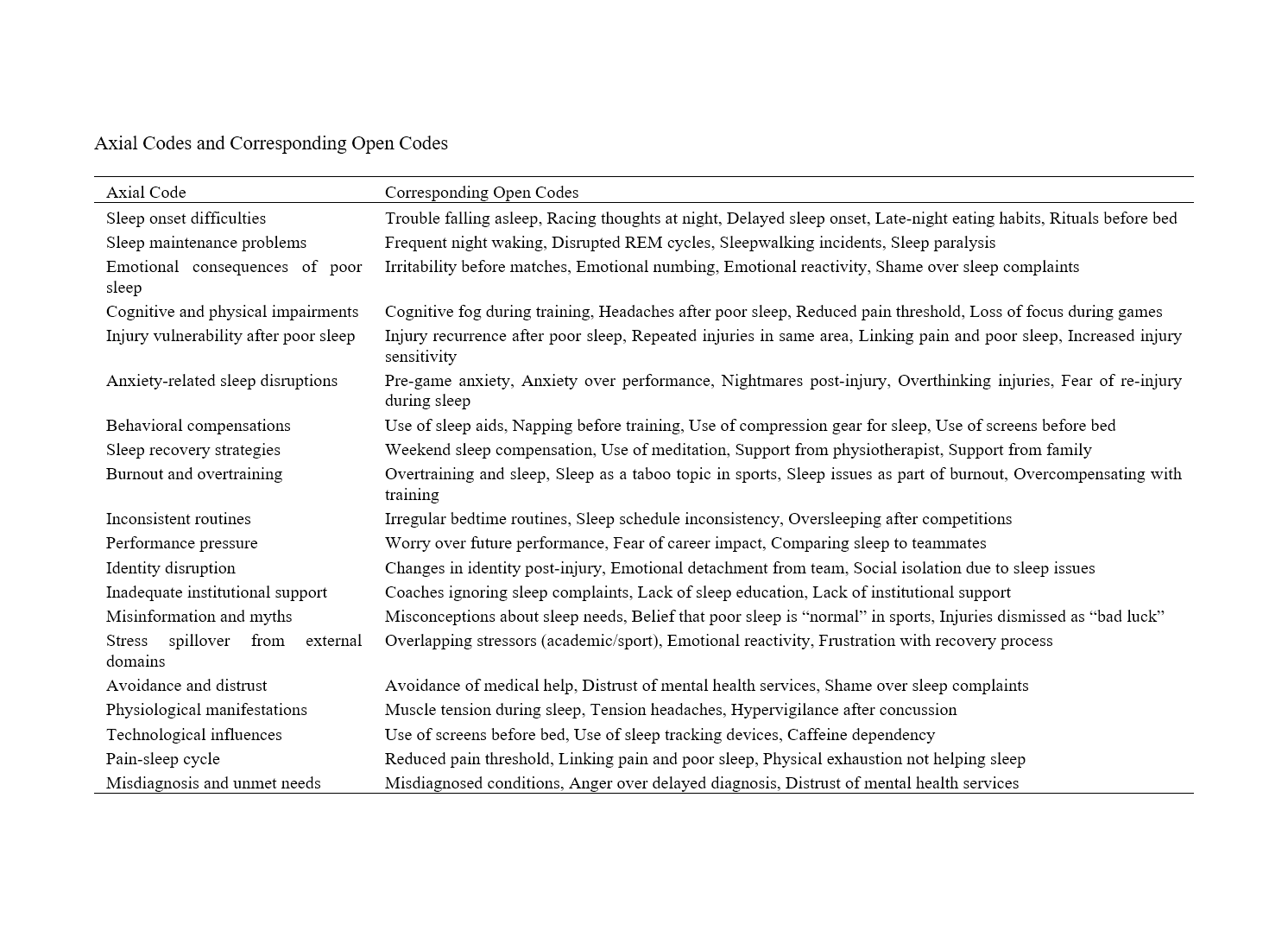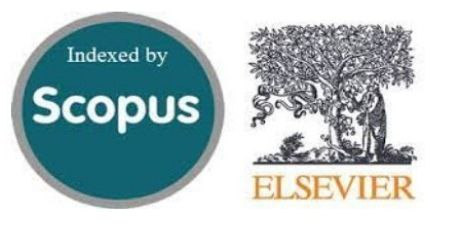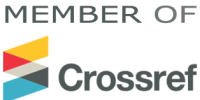A Qualitative Analysis of the Role of Sleep Disorders in Sports Injuries Among Competitive Athletes in Canada
Keywords:
Sleep disturbance, injury risk, athlete well-being, qualitative research, emotional resilience, recovery, sport cultureAbstract
Objective: This study aimed to explore how competitive athletes in Canada understand, experience, and cope with sleep-related challenges in relation to their injury histories.
Methods: Using a qualitative approach, we conducted semi-structured interviews with 31 athletes aged 19 to 34, representing both individual and team sports. All participants had experienced at least one sports injury and reported issues with sleep. The interviews were analyzed in three stages—open, axial, and selective coding—allowing us to move from detailed personal accounts to broader thematic insights.
Results: The analysis identified four interrelated themes. Disrupted Sleep Patterns captured athletes’ difficulties with initiating and maintaining sleep, commonly linked to stress, physical tension, and pre-sleep screen use. Emotional Burden of Sleep Loss highlighted the psychological toll of sleep disturbances, including heightened anxiety, irritability, and feelings of shame—particularly when performance declined. Heightened Injury Susceptibility reflected athletes’ perceptions that inadequate sleep contributed to greater injury risk and prolonged recovery. Finally, Systemic Barriers and Ineffective Coping pointed to a lack of institutional sleep education, cultural stigma surrounding rest, and reliance on unhelpful self-management strategies, which often compounded the problem.
Conclusion: Sleep issues in elite athletes are not just about feeling exhausted—they reach into deeper layers of well-being. Poor sleep affects not only how athletes perform, but also how they feel, recover, and even how they define themselves. Hearing these experiences directly from athletes themselves reveals an urgent need for more compassionate and informed support systems—ones that include meaningful sleep education, accessible mental health care, and a cultural shift in sports that values rest and recovery just as much as effort and endurance.
Downloads
References
1. Cameron A, Perera NKP, Fulcher M. Professional Athletes Have Poorer Sleep Quality and Sleep Hygiene Compared With an Age-Matched Cohort. Clinical Journal of Sport Medicine. 2020;31(6):488-93.
2. Driller MW, Dunican IC, Omond SET, Boukhris O, Stevenson S, Lambing K, et al. Pyjamas, Polysomnography and Professional Athletes: The Role of Sleep Tracking Technology in Sport. Sports. 2023;11(1):14.
3. Raikes AC, Athey A, Alfonso‐Miller P, Killgore WDS, Grandner MA. Insomnia and Daytime Sleepiness: Risk Factors for Sports-Related Concussion. Sleep Medicine. 2019;58:66-74.
4. Brandt R, Bevilacqua GG, Andrade A. Perceived sleep quality, mood states, and their relationship with performance among Brazilian elite athletes during a competitive period. The Journal of Strength & Conditioning Research. 2017;31(4):1033-9.
5. Sani SHZ, Greco G, Fathirezaie Z, Bădicu G, Aghdasi MT, Abbaspour K, et al. Which Dark Personality Traits Could Predict Insomnia? The Mediated Effects of Perceived Stress and Ethical Judgments. Behavioral Sciences. 2023;13(2):122.
6. Kosińska A, Niedbał P, Poborowska D, Kahan W, Szafrańska W, Polańska K, et al. Is Physical Activity an Effective Remedy for Insomnia? - A Review. Quality in Sport. 2024;20:54131.
7. Taheri M, Irandoust K. Morning exercise improves cognitive performance decrements induced by partial sleep deprivation in elite athletes. Biological Rhythm Research. 2020;51(4):644-53.
8. Zhang Y. Common Sports Injuries and Physical Treatments. Theoretical and Natural Science. 2023;20(1):115-21.
9. Salles JI, Silva C, Wolff A, Orwert L, Ribeiro P, Velasques B, et al. Anxiety, Insomnia, and Depression During COVID-19 Lockdown in Elite Individual and Team Sport Athletes. Psicologia Reflexão E Crítica. 2022;35(1).
10. Solmaz S, İnan M, Şahi̇n M. The Moderating Effects of Physical Activity on Social Anxiety and Sleep Disturbance: Managing Gaming Disorder in Young E-Sports Players. Frontiers in Public Health. 2025;13.
11. Mengxin S. Analysis on the Causes of Sports Injury in College Physical Education and Its Prevention Strategies. 2019.
12. Stepančev B, Stankov S. Roles of Football Team Physician in the Prevention and Therapy of Sports Injuries. Medicinski Casopis. 2023;57(1):27-33.
13. Abouhashem S. Neurosurgical Sports Injury (An Established Unit). Egyptian Journal of Neurosurgery. 2023;38(1).
14. Verkaik F, Ford ME, Geurtsen GJ, Someren EJV. Are Sleep‐related Beliefs and Behaviours Dysfunctional in People With Insomnia After Acquired Brain Injury? A Cross‐sectional Study. Journal of Sleep Research. 2023;33(3).
15. Ford ME, Verkaik F, Bouwmeester S, Geurtsen GJ. Do Changes in Beliefs and Behaviours Moderate Improvement in Insomnia After Acquired Brain Injury? Journal of Sleep Research. 2024;33(6).
16. Paryab N, Taheri M, Irandoust K, Mirmoezzi M. Effects of Melatonin on Neurological Function and Maintenance of Physical and Motor Fitness in Collegiate Student-Athletes Following Sleep Deprivation. International Journal of Sport Studies for Health. 2020;3(2):7-11.
17. Thomas SJ, Sakhuja S, Colantonio LD, Li M, Muntner P, Reynolds K, et al. Insomnia Diagnosis, Prescribed Hypnotic Medication Use, and Risk for Serious Fall Injuries in the Reasons for Geographic and Racial Differences in Stroke (REGARDS) Study. Sleep. 2022;45(5).
18. Adegbesan OA, Matthews JR, Pindar MN, Adewunmi CM. The Sleep Behaviour of Students’ Athletes in the Nights Prior to Competition. International Journal of Psychological Studies. 2020;12(1):24.
19. Wang H, Sun H. The Mediating Role of Rumination in the Relationship Between Insomnia and Non-Suicidal Self-Injury of College Students. Frontiers in Psychology. 2024;15.
20. Sharma JP, Parveen. A Scenario of Sports Facilities &Amp; Their Role in Preventing Injuries in Sports. International Journal of Enhanced Research in Educational Development. 2022;04(02).
21. Hou S, Twayigira M, Luo X, Song L, Cui X, Xie Q, et al. The Relationship Between Emotional Neglect and Non-Suicidal Self-Injury Among Middle School Students in China: The Mediating Role of Social Anxiety Symptoms and Insomnia. BMC Psychiatry. 2023;23(1).
22. Lee J, Lee H-C, Jeong H-N, Ha MS, Oh Y-S. Mediation Effect of Skill Levels in Relationship Between Degree of Participation and Injury Experience on Leisure Sports Participants : Based on Ball Sports With the Highest Injury Rate. Korean Journal of Sport Science. 2024.
23. Gowtham KNB, Mercy T. Mouthguards in Sports Dentistry: A Review. International Journal of Pedodontic Rehabilitation. 2023;8(2):18-25.
24. Defi IR. Rehabilitation Role in Sport Injury. Orthopaedic Journal of Sports Medicine. 2023;11(2_suppl).
25. Taheri M, Irandoust K, Ahmadi S. The effect of arginine supplementation following sleep deprivation on carbohydrate and fat metabolism, balance and fatigue index in female athlete students. Sport Sciences and Health Research. 2021;13(1):75-83.
26. Kaneda K, Maeda N, Nagao T, Ishida A, Tashiro T, Komiya M, et al. Exploring the Impact of Sports Participation on Social Capital and Health-Related Factors in Individuals With Spinal Cord Injury: A Cross-Sectional Study. Physical Therapy Research. 2024;27(3):128-35.
27. Yu A, Green J, Walker K. Sporting Injuries Amongst Children in Australia: A Review of the Literature. Australian Journal of Advanced Nursing. 2018;35(3).
28. Fu B, Fu X. Distributed Simulation System for Athletes’ Mental Health in the Internet of Things Environment. Computational Intelligence and Neuroscience. 2022;2022:1-9.
29. Corazza MCA, Corazza LA, Corazza JA. Otoneurological Evaluation and Rehabilitative Considerations After Head Trauma. 2023.
30. Röthlin P, Horvath S, Morgan GJ, Birrer D. Associations Between Sleep Disorder Symptoms, Self-Compassion, and Basic Psychological Needs in Swiss Elite Athletes. Current Issues in Sport Science (Ciss). 2023;8(2):056.

Downloads
Additional Files
Published
Issue
Section
License
Copyright (c) 2025 Veronica Longo , Daniela Gottschlich , Sarah Turner , Haixin Qiu (Author)

This work is licensed under a Creative Commons Attribution-NonCommercial 4.0 International License.







